 |
�t�D�r�D�`�q�l�x�@�l�t�r�d�t�l |
�i�n���C�j
| �����Q�Q�N�i�Q�O�P�O�N�j�U���T�� |
�����͎��R�s�����B
�w�ǂ̕��X�͂r���̈����i�j�ŁA�~�Y�[���[���Ȃǂ̌��w�ɍs�����炵���B
�A�����J�����u�I�v�V���i���c�A�[�v�Ƃ��Ċ�悵���炵���B
���E�E�E���͂���ɂ͕s�Q���B
���͈�l�Łu�t�D�r�A�[�~�[�~���[�W�A���v�ɍs�����Ƃɂ����B
��N�̂P�Q���ɗ������ɁA���܂��܋x�ٓ��Ō��w�ł��Ȃ������̂ł���B
���x�����͐��ɍs�������Ǝv���Ă����̂ŁA���̋@����킯�ɂ͂����Ȃ��B
���H�͂����Ɠ����}�[�P�b�g�̕Ћ��ɂ���J�t�F�e���X�ŃT���h�C�b�`�ƃR�[�q�[�̒��H�B
���̃c�A�[�E�E�E�E���H�͕t���Ă��Ȃ��B
�e���Ŏ��R�ɁE�E�E�Ƃ̂��ƂȂ̂ŁA���������J�t�F�e���X�ň�l�ŐH��������B
�܊p�̋@�����A�����ȓX�ŐH��������̂��������E�E�E
���������X�ŐH��������ƁA�X�̃X�^�b�t�Ɗ�Ȃ��݂ɂȂ�̂ŁA��b�����₷���Ȃ�Ƃ��������b�g������B�i�j
�H�����ς܂��āA�n�}��Ў�ɔ����ق������B
���Ȃ�̋��������E�E�E�E
����ς�A�k���Œ��̒�������˂Ζʔ����Ȃ��B�i�j
���Ԃ͂����Ղ肠��̂��B
 |
�t�D�r�D�`�q�l�x�@�l�t�r�d�t�l |
�O�����ɂ��B�e�������A������A������x�A�����ّO�ɓW������Ă�����{�R�̋���y��Ԃ�ꎮ�@���S�V�~���C���B�e����B
 |
�����ق̉��O�W���� |
�����ق͌��w�����Ƃ̂��ƁB
����Ⴀ�肪�����I�i�j
�ꌩ�A�債�����Ƃ̂Ȃ������ق��낤�Ǝv���Ă����̂����E�E�E
�����ɗ\�z�𗠐��Ă��ꂽ�B�i���j
����`��������������I�I
�����A���N���N���Ȃ��猩�w����B
���`��A����͈�l�ŗ��Đ����ł���B
�O���[�v�Ȃŗ����̂ł͂�������ƌ��w�ł��Ȃ��B
���̔����ق̗͐̂v�ǂ𗘗p���č���Ă���炵���B
�v�Ǔ����̖͌^���W������Ă����B
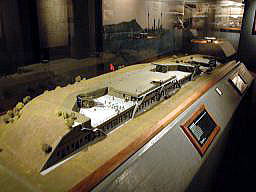 |
�v�ǂ̖͌^ |
 |
�v�ǂ̒��̒e��ɂ̃W�I���} |
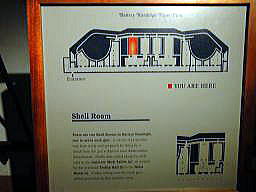 |
����������ꏊ�́E�E�E �̗̂v�ǂ̊G�̐Ԃ����߂��Ă���ꏊ�E�E�E |
| Shell Room |
| There are two shell rooms in Battery Randolph�Cone to serve each gun�D A variety of projectiles was kept ready and prepared for firing by a detail from the gun's thirteen-man ammunition Detachment�D Shells were rolled along the steel rails in the concrete Shell Tables (a)�Cor carried by the overhead Trolley Rail (b) to the Hoist Room (c)�D A false ceiling over the room gave added protection to this sensitive area�D |
 |
���̔����ق̂���ꏊ�E�E�E �����h���t�C��̑�C�̖͌^ |
 |
�ČR�E��Q�T�����A���Ɋւ���W�� |
| 25th Infantry Regiment |
| Seen here on parade in Honolulu�Cthe 25th Infantry arrived for garrison
duty at Schofield Barracks on January 15�C1913 with a strength of 29 officers and 801 enlisted men�D By October 1918�Cwhen the regiment left for border duty in Arizona�Cit had reached a war time strength of 72 officers and 2,264 enlisted ranks�D The 25th Infantry�Cone of the �eold army's�ffour segregated regiments�Cwas formed in March�C1869�D Prior to their service in Hawaii they served on the American frontier against the Indians�Cin the war with Spain and in the Philippine Insurrection�D |
�����ɂ́A���{�R�Ɋւ���W�����������B
���{�����ő����m�A�܂蓌��A�W�A�ɐi�o�����̂��Ƃ������Ƃɂ��ď����Ă���E�E�E
����ƁA�g�헪�Ɓh�R�{�\�Z�̐헪�ɂ��ĊȒP�ɏ�����Ă���B�i�܂�A�^��p���U������Ƃ����헪�j
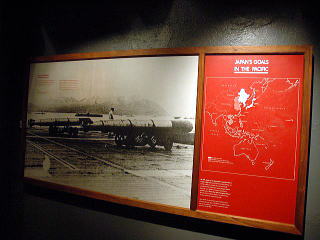 |
| JAPAN'S GOALS IN THE PACIFIC |
| By 1940�CJapan saw an opportunity to expand further its empire in East Asia�D British�CFrench�Cand Duch colonies�Crich with oil�Crubber�Ctin�C and other resources�Clay virtually unprotected while the European powers struggled against Germany�D Japan hoped to continue its expansion by establishing the �gGreater East Asia Co-prosperity Sphere�C�h through which it could gain access to raw materials and dominate markets for manufactured goods�D Japan would seize the territories and establish a strong defensive perimeter�Cdeep in the Pacific and Indian Oceans�Cthen rely on negotiations to achieve a satisfactory peace settlement with the Allies�D |
| JAPN'S STRATEGY |
| The United States Pacific Fleet�Cbased in Pearl Harber�Cwas the only force in the Pacific-East Asian area that posed a threat to Japan's success�D Neutralizing that fleet at the outset was the key�Cand surprise was critical�D Admiral Yamamoto�CJapan's master strategist�Cguided secret planning�Ctraining�Cand preparations in Kagoshima Bay�Csimilar to Pearl Harbor in depth and appearance�Cfor a decisive blow launched from Japan's aircraft carriers�D The Japanese developed special armer-piercing bombs and shallow-running torpedoes to fit Pearl Harbor's conditions�D |
�����ɂ́A������C���W������Ă����I
�قڊ����Ȍ`�̂��̂ł���B
�����������x�̂������̂͏��߂Č����E�E�E
����Ⴈ��ł͂Ȃ��낤���H
�����푈�Ɋւ���W�����������B
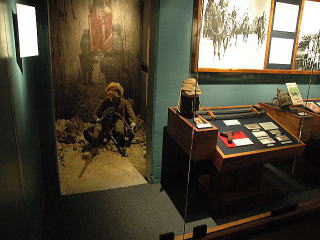 |
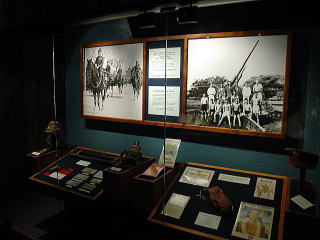 |
���ɂ���W�I���}�́A�����������d�@�֏e���\���Ă�����{���E�E�E
�o�b�N�̎ʐ^�́A�����̂ǂ����̒��̘H�n���e���\���ĕ������{���E�E�E
| Japan's Military Expansion Into China Began A China Of Events Leading To War With The United States |
WHY DID JAPAN INVADE CHINA �H Resource poor Japan desperately needed raw materials for continued industrial expansion and economic independence�D China was also a natural geographic buffer between Japan and her arch enemy�Cthe Soviet Union�D ��1932�CJapan seized China's northern province Manchuria ��1937�CJapan provoked China into open warfare |
�����ɂ́u�Ȃ����{�͒�����N�������̂��H�v�Ƃ������Ƃ�������Ă��܂������E�E�E�i���j
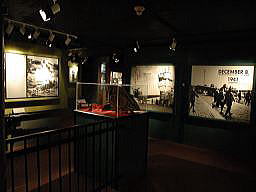 |
�����́w���R�����فx�ł����E�E�E ���{�C�R�̐^��p�U���̃R�[�i�[������܂����B |
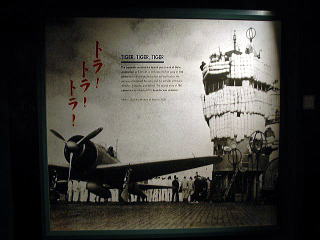 |
| TIGER�CTIGER�CTIGER |
| The Japanese reached the launch point north of Oahu undefected�D At 6�F00 AM�Cin darkness�Cthe first wave of 183 planes took off and struck the fleet in Pearl Habor�Cthe garrison at Schofield Barraks�Cand the airfields at Hickam�Cwheeler�CKaneohe�Cand Bellows�D The second wave of 180 planes was launched at 7�F15�D Surprise was complete�D |
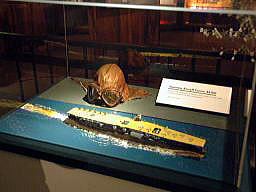 |
���w�ԏ�x�̖͌^�i�P/�S�T�O�X�P�[���j Japanese Aircraft Carrier AKAGI Flagship of Admiral Nagumo�CCommandant of the Attack Force�D Deck crews are spotting aircraft for the early morning launch�D |
 |
| NAVAL AIR POWER |
| The aircraft carrier strike force was revolutionary in naval warfare�D Japan recognized its potential early�Cbuilt a powerful fleet of carriers�C and produced the most advanced aircraft desighs by 1941�D The successful attack by British carrier planes against the Italian battle fleet at Taranto in 1940 convinced Japanese planners that their superior planes�Calong with the skill and tactical training of their pilots�Ccould succeed at Pearl Harbor�D The Nakajima B5N2 Type 97 �gKate�hattack plane was both a torpedo plane and level bomber�DIt was the most advanced plane of its type in service anywhere�D The Aichi D3A1 Type 99 �gVal�hdive bomber was used to attack ships and ground targets�DIt was highly maneuverable �F in the hands of a skilled pilot�Cit was an effective dog-fighter�D The Mitsubishi A6M2 Type 0 �gZero�h was the most advanced fighter of its day�DIt could out perform any other fighter then in service�DIt was used to escort the attack bombers and strafe airfields or ground targets�D |
���������ƂɁA���w����x�������㎵���͏�U���@�̎c�[�̈ꕔ���W������Ă����B
��N�A�g�n�V���g����h�Ɠ�l�Ō��Ă��ꂽ���w����x�̋㎵���͏�U���@�̓�����E���c�F���̈ԗ�ɗ����̂ł���B
���̋@�̂̈ꕔ�́A���Ă��ꂽ���w����x���ڋ@�T�@�̂����̂P�@�̂��́B
������������E�E�E���c�F���̓���@�̂��̂�������Ȃ��E�E�E�E
����`����́g�n�V���g����h�ɋ����Ă����˂I
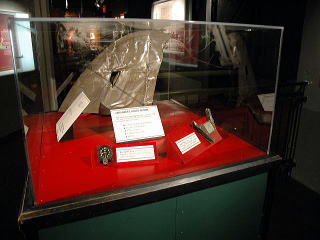 |
 |
| Horizontal Stabilizer section from one of five �gKate�hbombers shot down in the raid�D | |
���Ă��ꂽ�T�@�̋㎵���͏�U���@�̂����̂P�@�́u��������v�i���������j�����ł���B
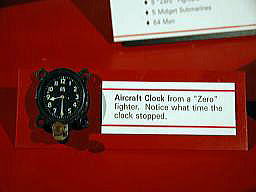 |
���Ă��ꂽ���̍q�v �i�W���R�O���������Ď~�܂��Ă���j Aircraft Clock from a�gZero�hfighter�D Notice what time the clock stopped�D |
| �n���C�̖h�q�Ɋւ���R�[�i�[ | |
 |
 |
���{�C�R�́A�P�X�S�Q�N�R���S���ɁA�Ăѐ^��p���g�U���h���Ă���炵���B
��^��s���ɂ��^��p�̒�@�Ɣ����������悤�����A�č����ɂ͔�Q�͂Ȃ������悤�ł���B
��s���ƁA������S�������ɍ���P�X�������̖͌^���W������Ă����B
 |
 |
| A SECOND BOMBING |
| Kawanishi H8KI flying boat Y-71�Cone of two that made a long-range reconnaissance and night bombing attempt against Pearl Harbor�CMarch 4�C1942�DNo damage was done�C the bombs fell harmlessly on Tantalus�Cand the planes returned to their base in the Marshall Islands�D |
���C�L�L�r�[�`�̖h�q���E�E�E
���{�R���㗤���Ă��邩������Ȃ����Ďv�����̂��낤�˂��E�E�E
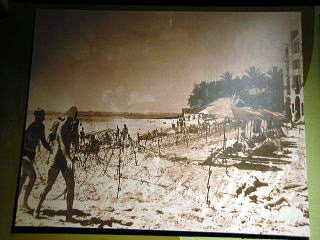 |
 |
| WIKIKI BEACH | |
| The Army quickly prepared for possible invasion with machine gun nests
at all likely landing beaches�Cincluding Waikiki�D In short order�Cthe lsland of Oahu was surrounded with 4,000,000 feet of barbed wire and 4,000 pillboxes�D |
|
�n���C�̎s�������́A���{�R�̍ēx�̍U���Ƃ����g�ň��h�ɔ������̂��������E�E�E
 |
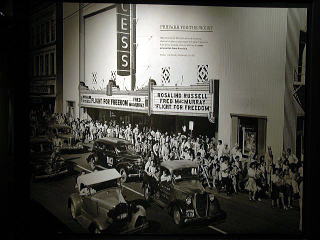 |
| PREPARE FOR THE WORST | |
| With December 7th fresh in their memory�CHawaii's citizens cooperated willingly
to prepare for further attacks�Ceven practicing for mass evacuation from Honolulu�D |
|
�h�[���b�g���ɂ����{�{�y��P�Ɋւ���W�����������B
 |
|
| Tokyo Raid | |
| A Daring Attack on the Enemy Heartland After Pearl Harbor the Japanese moved amazingly fast throughout the southern Pacific�C so fast that their original one-year objectives were achieved in only four months�D Allied morale was desperately low�D In an exceedingly daring and dangerous attempt to force the Japanese to curtail their rapid expansion and lift American morale�CLieutenant Colonel Jimmy Doolittle prepared a squadron of Volunteers to bomb Japan�D the raid would require American aircraft carriers�CJapan's most coveted naval targets�C to venture deep into enemy territory�D The mission was complicated by the fact that none of the pilots had ever launched a land-based medium bomber from an aircraft carrier�D Fortunately�Call sixteen Army B-25 Michell aircraft tookoff successfully�Cbut none returned to service and several airmen were captured and executed�D A Strategic Shock The results of the attack surprised the Allies and shocked the Japanese�D Several millitary and industrial targets had been destroyed�Cbut the psychologic effect made the greatest impact�D The Tokyo Raid has been called the most strategically significant air attack during all of World War �U�Cnot for the damage inflicted but for the events it set in motion�D After the Doolittle Raid Japan accepted Admiral Yamamoto's plan to extend Jpan's air defense perimeter�D Midway became Japan's next target�Cand to insure success the imperial Navy amassed the largest invasion fleet ever seen in the Pacific�D |
|
 |
Lt�DCol�DJames H�DDoolittle (fourth from right) and his crew reunited after their plane crashed�D Photograph shows the Chinese officals who helped save their lives�D Not all crews were so fortunate�D |
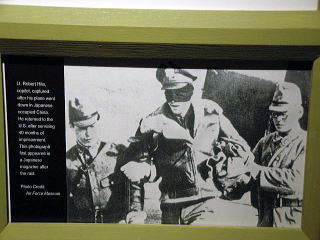 |
Lt�DRobert Hite�Ccopilot�Ccaptured after his plane went down in Japanese occupied China�D He returned to the U�DS�Dafter surviving 40 monthes of imprisonment�D This photograph first appeared in a Japanese magazine after the raid�D |
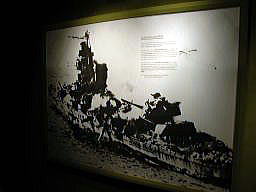 |
�~�b�h�E�F�C�C��Ɋւ���W�� �ʐ^�͊C���̓��{�C�R�E�d���m�́w�O�G�x |
| MIRACLE AT MIDWAY |
| Simultaneous with the Hawaii attack�CJapan struck throughout the Pacific - Wake Island�CGuam�Cthe Philippines�CHong Kong�CMalaya�Cand Thailand -seizing their defensive perimeter�D The psychological impact of Dolittle's Tokyo raid in April 1942�Cforced Japan to try to strengthen its perimeter by mounting an offensive to occupy Midway Island�Cat the western end of the Hawaiian chain�Cand the Aleutians�D Japanese planners hoped to lure American carrier forses into a decisive battle�D From Midway�CJapan could launch air attacks to make Hawaii untenable as a base�D But using information from intercepted radio messeges�Cthe U�DS�Dwas ready when the Japanese came in June�D Army bombers spotted the fleet�Cand Navy carrier planes ambushed it�D Four of the Japanese carriers that raided Hawaii were sunk�D The miracle at Midway turned the war around�D Hawaii was safe�Cand the United States switched from defense to offense�D |
 |
���{�R�̕���̓W���R�[�i�[ |
�n���C�ŕҐ����ꂽ�����Ɋւ���W���E�E�E
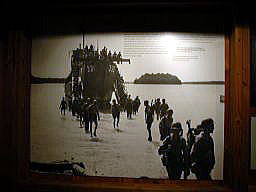 |
�ʐ^�́A�P�X�S�R�N�V���Q�Q���Ƀj���[�W���[�W�A�ɏ㗤������Q�T�����t�c�E������P�U�P�A�� |
���̑�Q�T�����t�c�́A�K�_���J�i�����ł����{�R�Ɛ�������A��햖���ɂ̓t�B���s���̃��\�����ɏ㗤���ē��{�R�Ɛ���Ă���B
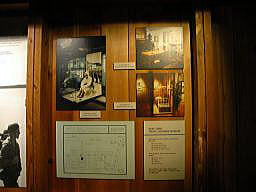 |
�W���p�l���ɂ��ƁA�ǂ����A���̕����Ɋւ��锎���ق�����炵���I ���`��E�E�E�E���ɍs���������E�E�E���Ԃ��Ȃ��I�i��܁j ���ƁA�P���A���R���Ԃ�����Ȃ��` �c�O�ł���B |
���n�l�����Ɋւ���W���E�E�E�E
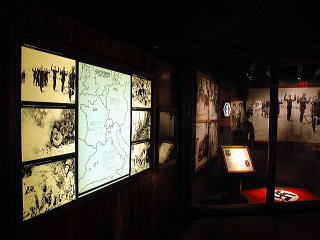 |
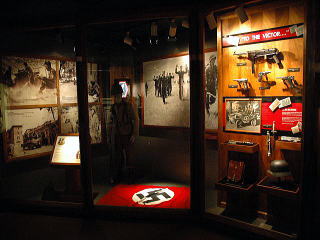 |
�n���C�̓��n�A�����J���́A���[���b�p����Ńh�C�c�R�Ɛ�����悤�ł���B
 |
| HAWAII JAPANESE AMERICANS |
| The war immediately raised the loyalty question of Hawaii's 160,000 ethnic Japanese�Cone third of the population�D After the attack�C1,400 suspects were arrested and interned in camps�Cbut sheer logistics prevented the mass relocation that was imposed on mainkand Japanese�D 300 Territorial Guardsmen were dismissed from service�Chalf joined the Varsity Victory Volunteers�G 1,500 National Guardsmen continued to serve under constant scrutiny�Cbut no more were enlisted�D By May 1942�Cafter demonstrating loyalty and enthusiasm�Cmany of these Americans of Japanese ancestry (AJAs) were organized into the Hawaiian Provisional Battalion and were sent to the mainland for training�D At Camp McCoy�CWisconsin�Con June 12th�Cthe unit was officially designated the 100th Infantry Battalion (Separate)�D |
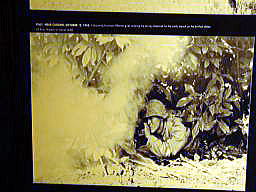 |
�P�X�S�R�N�P�O���Q�Q���A�C�^���A�̃J�b�V�[�m�̋߂��ɂāE�E�E�E A Browning Automatic Rifleman gives covering fire during rehearsals for the costly assault on the fortified abbey�D |
 |
�P�X�S�S�N�āA�C�^���A�ɂāE�E�E �U�����x�������P�O�O����E�U�O���������C�̕��m���� |
��P�O�O����ł͏�̒ʖ�Ƃ��đ����m����Ŋ������m�����������ŁE�E�E
�ʐ^�́A�����������{���ߗ���u�₷����n�A�����J���B
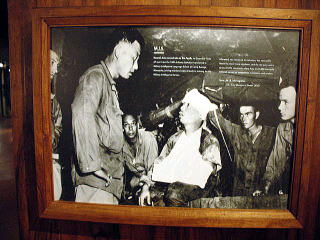 |
| M�DI�DS |
| Hawaii AJAs served also in the Pacific�D In December 1942�C67 men from the 100th Infantry Battalion transferred to Military Intelligence Language School at Camp Savage�CMinnesota�Cjoining mainland AJAs already in training for the Military Intelligence Service�D Afterward�Ctwo remained as instructors�Cfive returned to Hawaii to recruit more volunteers�Cand the rest were sent to various Pacific commands where they�Cand 6,000 more who followed�Cserved as interpreters�Ctranslators�Cand analysts�D |
���n�A�����J�l�ŕҐ����ꂽ�����́A��P�O�O��������Ƒ�S�S�Q�A���퓬�c�E�E�E
| Bought With Blood |
| The 100th Battalion went into combat near Salemo�CItaly�CSeptember 1943�D Nine months later�Cthe 442nd Regimental Combat Team joined them and they fought together as a unit through the rest of the war�D From the begining�Cthe Japanese American fought with distinction�Cspearheading offensives�Cliberating town after town�Cand continually pushing the Germans north�D On April 4�C1945�Cusing a classic diversion in their first try�Cthey cracked the Nazis' Gothic Line that had withstood penetration for five months�D The price was high�D Japanese-Americans suffered extremely high casualities throughout the war�C earning the nickname the �gPurple Heart�h outfit�D |
| What Made Them Tick ? |
| Because of Pearl Habor�Cthe Japanese American soldier faced great prejudice and distrust�D They felt compelled to fight all the harder to prove their loyalty�D Combat skills�Choned through prolonged intensive training�Ccombined with their sense of community and aloha spirit�Cbuilt tremendous teamwork�D The result was unbreakable cohesion in battle and unshakable espirit de corps�D �gGo for broke�h says it all ! |
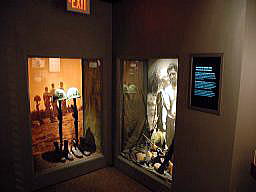 |
�x�g�i���푈�Ɋւ���W�� |
����ɂ̓w���R�v�^�[���W������Ă������A���傤�lj������炵����������֎~�B
�������E�E�E��Ǝ҂͉��̂����ʕ��𒅂Ă���B
�Ȃ�ł��낤�H������������E�E�E�E�H�����H
���傤�NJK�i�̗x���ł���������ƈ��ɐq�˂���u�H�����ł��v�Ƃ̂��ƁB
����ɂ��Ă��ނ̌��t�͒��J�ł���B
���Ƃ̉�b�̕Ԏ��ɂ͕K���Ō�Ɂu�T�[�v��t����̂ł���B
�ʂɎ��͌R�l�ł͂Ȃ��̂����E�E�E
�������������قɂ͌��R�l���������邾�낤����u�T�[�v��t���ĉ�b�����������ԈႢ���Ȃ��Ƃ������ƂȂ̂��낤���H
���{�ł͂��������h�ӂ̕\�����͂Ȃ����낤�Ȃ��`
���q���ł͂ǂ��Ȃ�H
�ޖ��������q���ւ̌h�ӂ̕\�����Ƃ����͉̂�������̂��낤���H
����o�����Ȃ�����A�����������Ƃ͂Ȃ����H
����ɂ��Ă��R���W�̔����ق̏C����ێ��Ǘ��͍H�������S���Ƃ����͖̂ʔ����B
�l����͂�����Ȃ��̂��낤����E�E�E�i�j
���Ԃ̋Ǝ҂ɗ��ނ����オ�肩�ȁH
���{�����q�����g���Č����{�݂��C�������肵����A���Ȃ�����o�����Ȃ��낤���H�i�j
���w��A�~���[�W�A���V���b�v�Ŗ{���B
![]() �@�g�b�v�y�[�W�ɖ߂�@�@
�@�g�b�v�y�[�W�ɖ߂�@�@![]() �@�����L�ɖ߂�
�@�����L�ɖ߂�
| SEO | [PR] ����!�����u���O �����z�[���y�[�W�J�� �������C�u���� | ||
